Open Journal of Geology
Vol. 2 No. 3 (2012) , Article ID: 21385 , 12 pages DOI:10.4236/ojg.2012.23014
Geothermobarometry of Askaoun Pluton in Ouzellarh-Sirwa Promontory (Central Anti-Atlas; Morocco)
1Applied Geology and Environmental Geology Laboratory, Faculty of Sciences, Ibn Zohr University, Agadir, Morocco
2Faculté Polydisciplinaire de Taroudant, Hay El Mohammadi (Lastah), Taroudant, Morocco
Email: atoummite@yahoo.fr
Received February 28, 2012; revised March 20, 2012; accepted April 9, 2012
Keywords: Askaoun Pluton; MMEs; hornblende thermobarometry; Ouzellargh-Sirwa promontory; Anti-Atlas; Morocco
ABSTRACT
Rocks of the late Neoproterozoic Askaoun pluton (558 ± 2 Ma) located in the Ouzellarh-Sirwa promontory (Anti-Atlas) include magmatic microgranular enclaves (MMEs) ranging from rounded to ovoid in shape, dark and fine grained and generally 5 to 10 cm in size, some reaching a size of 50 cm. They are composed of microdiorite, quartz microdiorite and micromonzodiorite, whereas the felsic host rocks comprise mainly quartz-diorite and amphibole-biotite granodiorite based on mineralogical compositions. The mineral assemblage is similar to those described in their hosting granitoids but with different proportions. In this study composition of minerals is used to describe the nature of the magma and estimate the pressure, temperature and oxygen fugacity at which Askaoun pluton is emplaced. Based on chemistry of biotite Askaoun pluton formed from calc-alkaline magma. Compositions of plagioclase (An5 - An29); hornblende (Mg ≠= 0.59 - 0.65) and biotite (Mg ≠= 0.49 - 0.55) of MMEs are slightly distinct or similar to those of host rocks (An7-40; hbl Mg ≠= 0.64 - 0.69; Bi Mg ≠= 0.49 - 0.50) which suggest partial to complete equilibration during mafic-felsic magma interaction. The coexisting hornblende and plagioclase (hornblende-plagioclase thermometry), Al content in hornblende (aluminum-in-hornblende barometry) and the assemblage titanite-magnetite-quartz were used to constrain the P, T and fO2 during the crystallization of the parent magmas. The Askaoun pluton was emplaced at temperature ca. 504˚C - 633˚C and at pressure ca. 0.9 - 4.66 ± 0.6 Kbars (average depth = 6.5 km) from a highly oxidized magma (logfO2 = −24.8 to −19.2).
1. Introduction
The Ouzellarh-Sirwa Promontory (OSP) is located to the north of the Anti-Atlas belt (Morocco). It is bounded to the south by the North High Atlas Fault (NHAF), and to the north by the Anti-Atlas Major Fault (AAMF); separating the Cenozoic Ouarzazate basin to the North-Est and the Souss basin to the South-West, which extends towards the Atlantic ocean (Figure 1). In the north of the AAMF, the OSP is covered to the South-East by the large Cenozoic Sirwa volcano culminating at more than 3300 m [1,2]. It is also the locus of the largest Panafrican granitoids outcrops in the Anti-Atlas, indicating that it was a preferential locus for magmatic intrusions and extrusions. Many works related to the petrographical and geochemistry characterizations as well as geological mappings have been undertaken within the studied area by several authors. [3] has studied the zircon typology of the Askaoun Granodiorite and suggested a calco-alkaline parentage of those granodiorite.
[4,5] have investigated the same area and have performed a lithostratigraphy, geochemistry and geochronological study of plutonic, volcanic and sedimentary rocks outcropping within the Sirwa window.
Recently, ([6], in reviews) have done a study of isotopic geochemistry and geochronology of the granitoids and MMEs from the Tifnoute valley. This Askaoun pluton is one of the Ediacaran rocks in the Anti-Atlas belt. According to them, the plutonic rocks of the Tifnoute valley are a typical post-collisional mainly juvenile source in a metacratonic setting in the Anti-Atlas belt.
However, no study on the conditions of crystallization of Askaoun pluton was made.
In the last three decades, many thermobarometric equations using the composition of calcic amphiboles have been proposed for computation of pressure, temperature, oxygen fugacity [7-15] which prevailed during crystallization of the magma.
Hence, this paper aims to 1) describe the mineral compositions of main rocks-forming of rocks and 2) estimate the physico-chemical conditions (pressure and temperature of crystallization and oxygen fugacity prevailing during crystallization of Askaoun granitoids.
2. Geologic Settings
The Askaoun Pluton with N-S trend occurs as an elongated body exposed in the Ouzellarh-Sirwa promontory, Anti-Atlas, Morocco (Figure 1). This pluton is intrusive within the volcano-detritic rocks of Saghro Group, and is crosscut by important mafic dyke swarm mostly NE-SW oriented. The main rock types of the pluton are quartz diorite and granodiorite. These plutonic rocks comprise abundant microgranular mafic enclaves (MMEs). These MMEs were studied in detail by [3], ([6] in reviews) who recorded monzodioritic, quartz dioritic and dioritic composition.
The zircon SHRIMP analyses of zircon from the Askaoun pluton indicate a crystallization age of 575 ± 8 Ma [4]. However, this pluton dated from the Askaoun granodiorite by LA-ICP-MS on zircon at 558 ± 2 Ma, ([6], in reviews). This confirms that the pluton is subcon-temporaneous to the volcanic and volcano-detritic rocks from the huge Ouarzazate Group (580 - 545 Ma), marking the post-collisional transtensional period in the AntiAtlas and which evolved towards alkaline and tholeiitic lavas in minor volume at the beginning of the Cambrian anorogenic intraplate extensional period.
The geochemical analysis of the major and trace elements, show that their MMEs and host rocks from Askaoun pluton belong to alkali-calcic series (high K-calcalkaline) ([6], in reviews). The recent Sr-Nd isotopic study by ([6], in reviews), confirms that the MMEs and host rocks from this pluton are mainly a juvenile source corresponding to a Pan-African metasomatized lithospheric mantle partly mixed with an old crustal component from the underlying West African Craton (WAC).
3. Analyticals Methods
Two samples of Granitoids and two samples of the MMEs have been selected for analysis of mineral phases. Thin section preparation and polishing for microprobe analysis were done in the Applied Geology and Environmental Geology Laboratory, Faculty of Sciences, Ibn Zohr University. The electronprobe microanalysis of amphibole; feldspars and biotite from selected DZA, TA2, IM2, Ab6 samples were carried out on a CAMECA SX-50 Electron Microprobe at the Service Commun de Microanalyse, Université Henri Poincaré, Nancy, which operated at probe current of 10 nA with an accelerating voltage of 15 kV. Counting times were usually 20 s for each element. The electron beam diameter was kept 1 μm. Structural formulae for amphibole, Feldspars and Biotite analysis were calculated respectively on the basis of 23; 8; and 22 oxygen. The chemical analysis and calculated structural formulae are listed in Tables 1-3.
4. Petrography of the Askaoun Pluton and MMEs
4.1. The Askaoun Pluton
It covers a surface of about 600 km2. In its eastern part, the contact with the hosting volcanodetritic rocks of Saghro Group is sharp (Figure 1). It includes quartz diorite and amphibole-biotite granodiorite. The granodiorite is grey to pink, medium-grained; in addition to plagioclase, amphibole and biotite, the quartz crystals form interstitial or poekilitic megacrysts and the K-feldspar (perthitic orthoclase or kaolinitized microcline) appears as anhedral megacrysts. Accessory minerals are apatite, zircon and epidote with rare titanite. The quartz diorite is grey, medium to coarse-grained, with euhedral plagioclase (60% - 70% in volume) frequently transformed to sericite, quartz (14% - 17%), amphibole and biotite. Secondary chlorite, sericite, epidote, and opaque minerals are present.
4.2. Microgranular Magmatic Enclaves (MMEs)
MMEs are abundant in Askaoun pluton. They are rounded to ovoid in shape, dark and fine grained and generally 5 to 10 cm in size, some reaching a size of 50 cm [5]. They are commonly porphyritic and range from microdiorite, quartz microdiorite and micromonzodiorite. The mineral assemblage is similar to those described in their hosting granitoids but with different proportions. Zoned, often altered, plagioclase is preponderant (43% - 65%) with abundant hornblende (5% - 19%), rarer quartz and subordinate biotite. The monzodiorite contains nearly 20% of K-feldspar. Ouralitized clinopyroxene has been identified sporadically such as sample (Ab6) from the Abrouay region. Accessory minerals include epidote, apatite and euhedral Fe-Ti oxides.
5. Results and Discussion
5.1. Minerals Chemistry
5.1.1. Hornblende
Hornblende, the most common ferromagnesian mineral, occurs as individual crystals or aggregates with biotite both in MMEs and host rocks. Amphiboles in the granitoids and their MMEs are of igneous origin, as their Si values do not exceed the 7.50 a.p.f.u. (atoms per formula
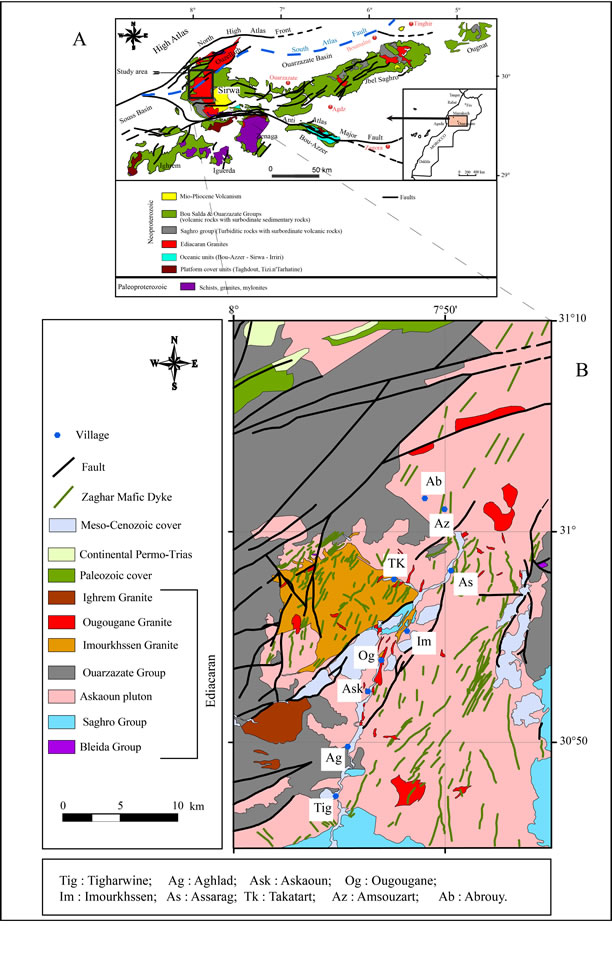
Figure 1. (a) Schematic map of the Moroccan Anti-Atlas and localization of published Ediacaran magmatic ages. Map modified from [4,44]; (b) Geological map of the Tifnoute valley. Modified from the geological map of [45,46].
unit) of the limit for igneous amphiboles [16,17]. The results of representative analysis of amphiboles from MMEs and host rocks are given in (Table 1). In the IMA-approved nomenclature [17,18] these amphiboles are magnesio-hornblendes (Figure 2). The amphibole composition of MMEs and host rocks are indistinguishable: The Mg-number [(Mg ≠= atomic ratios Mg/(Mg + Fe2+)] varies between 0.59 - 0.65 in MMEs and is similar to that of the host rocks (0.64 to 0.69), and a Si content varies between 6.62 to 7.38 atom per formula unit (apfu) in host rocks and between 7.01 to 7.27 (a.p.f.u.) in the MMEs (Table 1).
5.1.2. Feldspars
Representative analysis of plagioclase and their calculated formulae are given in (Table 2). The plagioclase composition ranges from Ab37 An7 Or1 to Ab91 An40 Or20 in the host rocks and from Ab63 An5 Or0.2 to Ab95 An29 Or28 in the MMEs. In the [19] classification diagram for plagioclase (Figure 3) the rocks plotted mainly in the albite, oligoclase and andesine field.
5.1.3. Biotite
The results of representative analysis of biotites from MMEs and host rocks are given in (Table 3). This analysis of biotite from MMEs and host rocks indicates compositions lying approximately midway between phlogopite and annite (Figure 4). The biotite of MMEs and host rocks is Fe-rich [Fe/(Fe + Mg) = 0.45 - 0.51; Figure 4; Table 3]. The Mg-number [(Mg ≠= atomic ratios Mg/
(Mg + Fe)], varies between 0.49 and 0.55 in the MMEs similar to the host rocks (0.49 - 0.50), (Table 3). The alumina saturation index of biotite (AlT/(Ca + Na + K); ASI) is significantly low (1.17 - 1.34) in both, and reflects decreased alumina activity in the crystallizing magma [20].
5.2. Magma Typology
Biotite chemistry has been widely used to infer the nature of granitic magma and tectonic setting [21-32].
[21] suggested discrimination diagrams on the basis of major elements (FeO, MgO, Al2O3) of biotites in igneous rocks crystallized from A, P and C magma types. Based on his classification; biotites in anorogenic alkaline suites (field A) are mostly iron-rich, siliceous biotites (near annite), with an average FeO*/MgO ratio of 7.04; those in peraluminous (including S-type) suites (field P) are siderophyllitic in composition and have an average FeO*/ MgO ratio of 3.48; whereas biotites in calc-alkaline orogenic suites (field C) are moderately enriched in Mg; with an average FeO*/MgO ratio of 1.76. It should be noted that the average FeO*/MgO ratio in biotite doubles from calc-alkaline through peraluminous to alkaline suites (FeO* = total Fe). Based on the biotite discrimination diagram of the Abdel-Rahman (1994); these biotite of Askaoun granodiorite and MMEs are mostly located in calc-alkaline field (Figure 5). This corroborates with the geochemical features undertaken in the area using major and trace elements ([6], in reviews).

Figure 2. Amphiboles classification diagram of [17] for Askaoun Pluton.
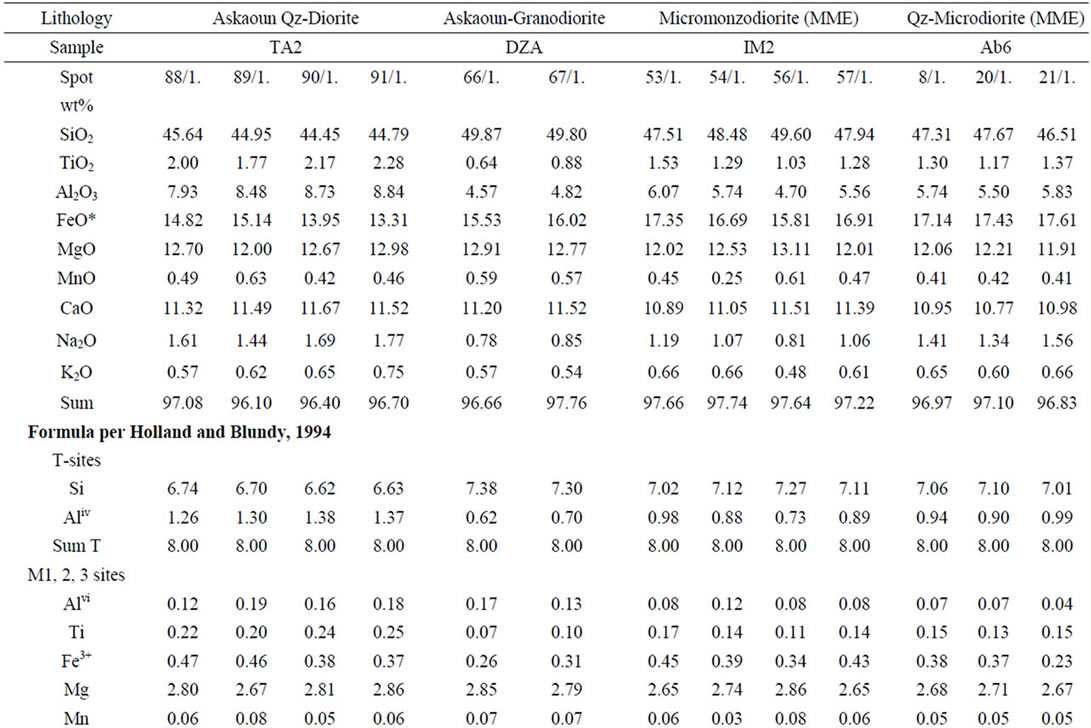
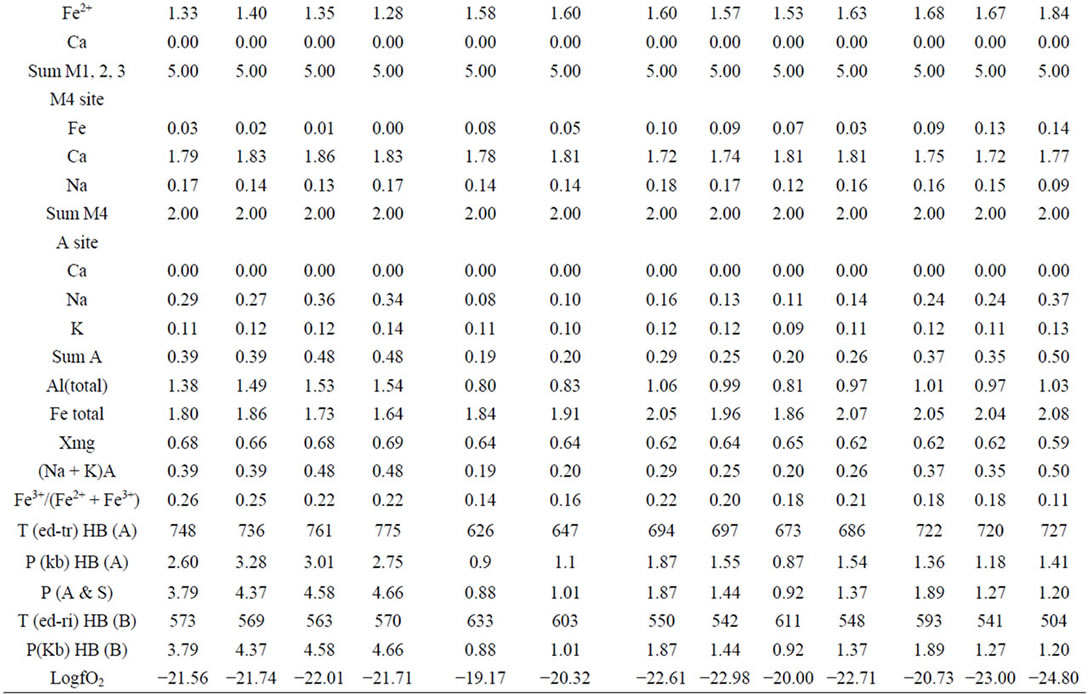
Table 1. Representative hornblende microprobe analyses from Askaoun Pluton and calculated thermobarometric results.
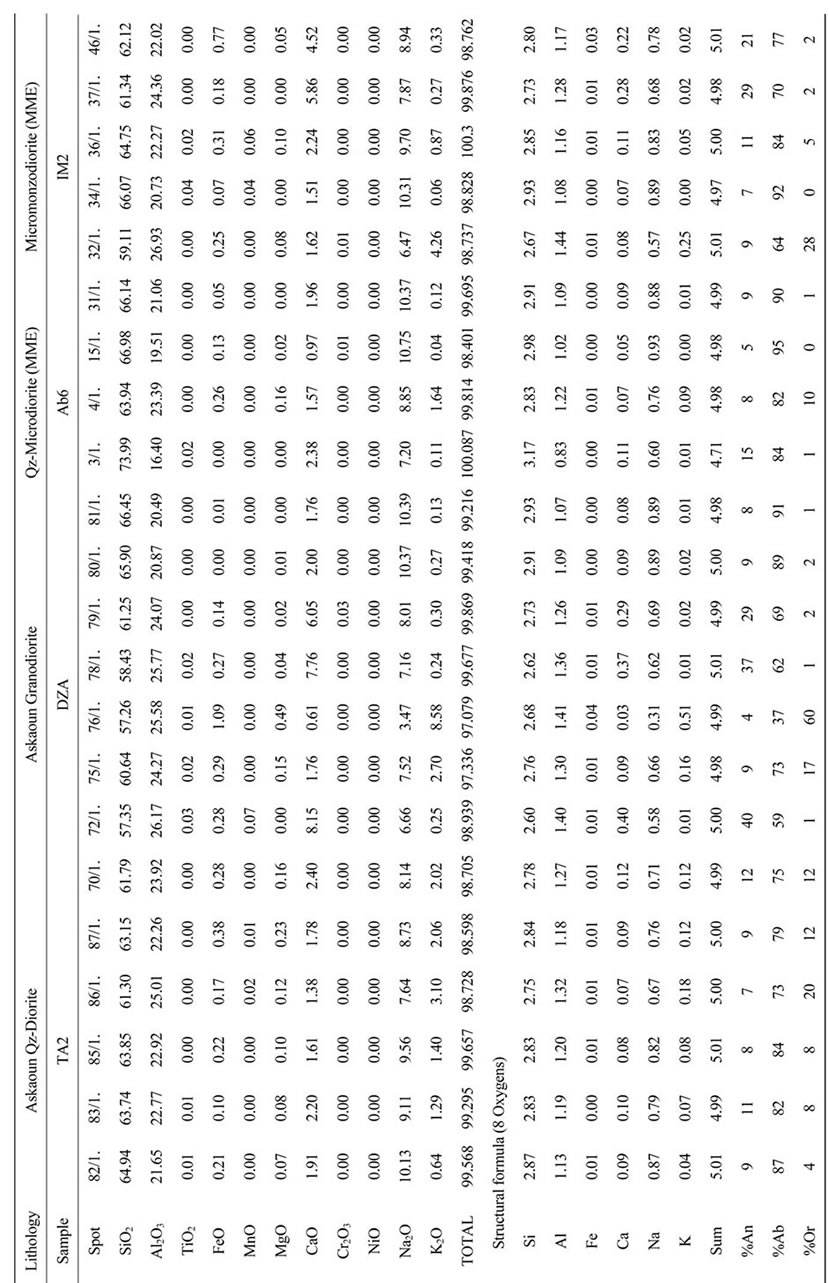
Table 2. Electron microprobe analysis of plagioclase from Askaoun Pluton.
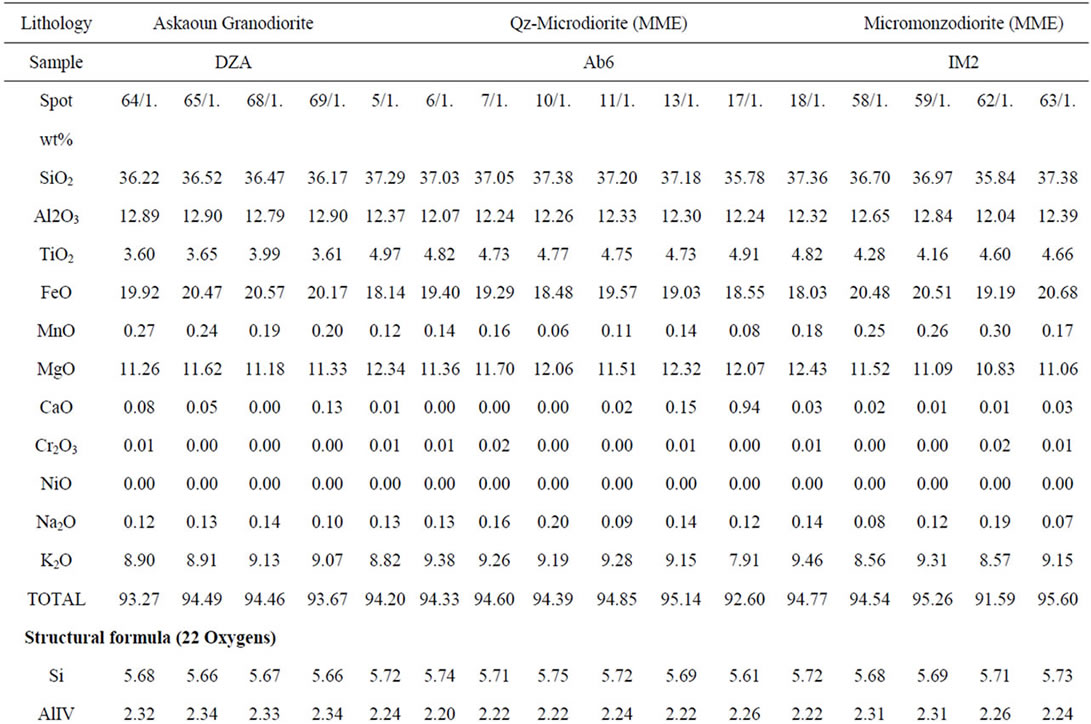
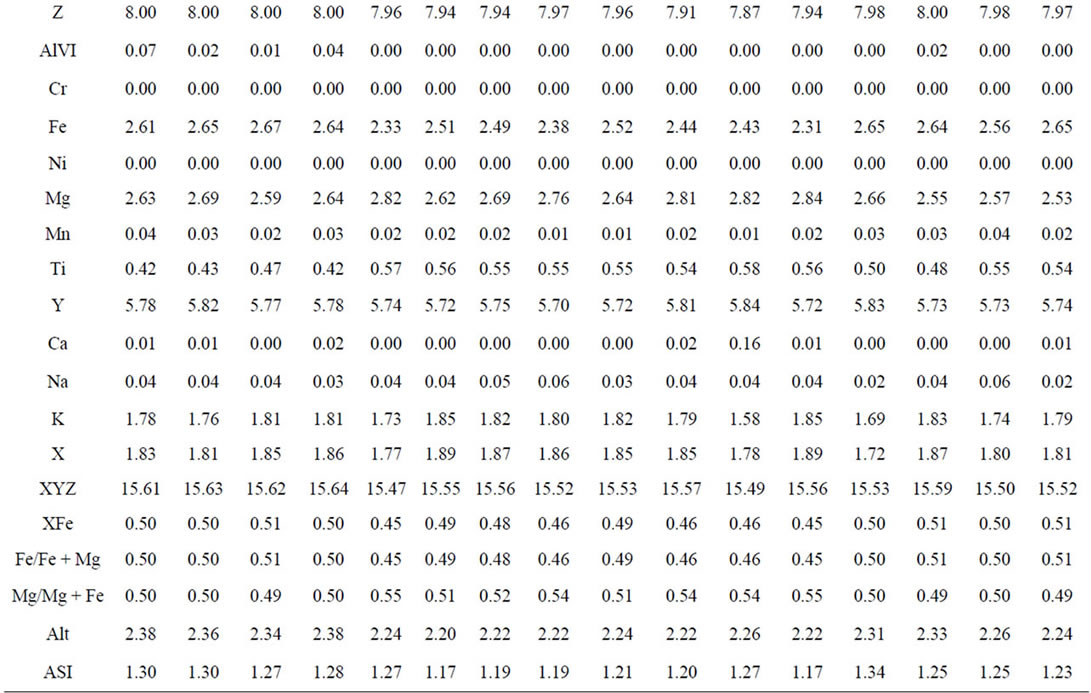
Table 3. Representative analysis of biotite from Askaoun Pluton.
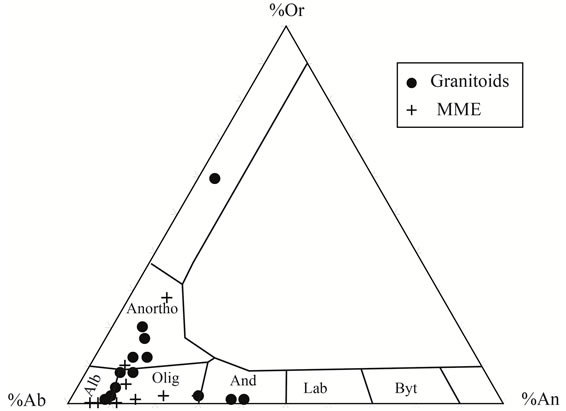
Figure 3. Feldspars chemistry in the Or-Ab-An diagram of [19] (Alb: Albite; Olig: Oligoclase; and: Andesine; Lab: Labradorite; Byt: Bytwonite).
5.3. Hornblende-Plagioclase Thermometry
As hornblende and plagioclase commonly coexist in calc-alkaline igneous rocks, they have been used for thermometry [10,12,33,34]. Based on hornblende solidsolution models and well constrained natural and experimental systems, two hornblende-plagioclase geothermometers (thermometer A and B) were calculated by [12]. Thermometer A is based on the edenite-tremolite reaction (edenite + 4 quartz → tremolite + albite), which is applicable to quartz-bearing igneous rocks: and thermometer B is based on the edenite-richterite reaction (edenite + albite → richterite + anorthite), which is applicable to both quartz-bearing and quartz-free igneous rocks [12,33]. On the basis of an assessment of the different Al-in-hornblende thermometric algorithms on data from plutonic rocks, [14] concluded that edenite-richterite thermometer is the most reliable calibration. Therefore, we used edenite-richterite thermometer to calculate the temperature of crystallization of the Tifnoute valley plutonic rocks and their MMEs. Equilibration temperature for hornblend-plagioclase assemblage were calculated based on iteration using [13] pressure at various thermometers. The (Table 1) shows the types of thermometers applied for estimation of the temperature. From analyzed rocks, the calculated temperatures (ediniterichterite thermometer) are in the range 505˚C to 611˚C for host rocks and 563˚C to 633˚C for MMEs.
5.4. Al-in-Hornblende Barometry
Understanding the evolution of a granitoid pluton requires knowledge of the depth at which various minerals crystallized and the amount of post-crystallization upward movement. The pressure of emplacement of a granite pluton can be constrained by geologic and petrologic criteria.
[7,8] suggested that, in the presence of an appropriate buffer assemblage (amphibole + plagioclase + K-feldspar/quartz, at medium to high oxygen fugacity conditions), the total Al content of calcic amphibole increases linearly with pressure of crystallization. Subsequent field-based and experimental studies [9,11,13,35] provided general confirmation of increasing Al content of hornblende with increasing pressure. In the last two decades, Al-in-hornblende barometry has been widely used to calculate pressures of magmatic crystallization, and
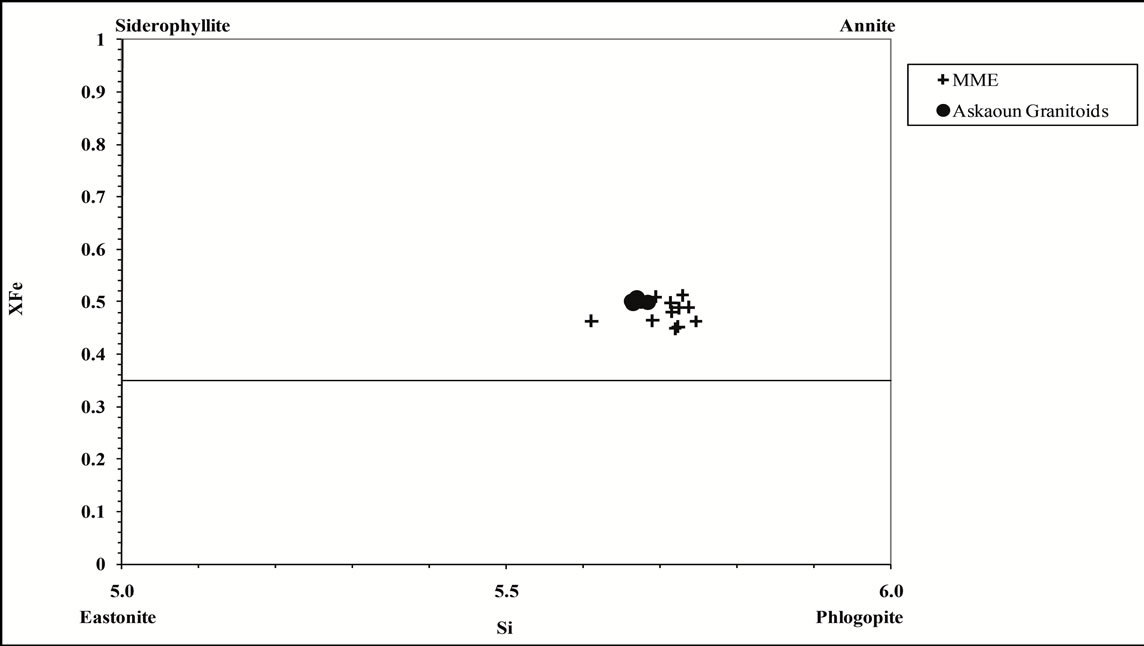
Figure 4. Biotite chemistry plotted in Si vs XFe diagram.
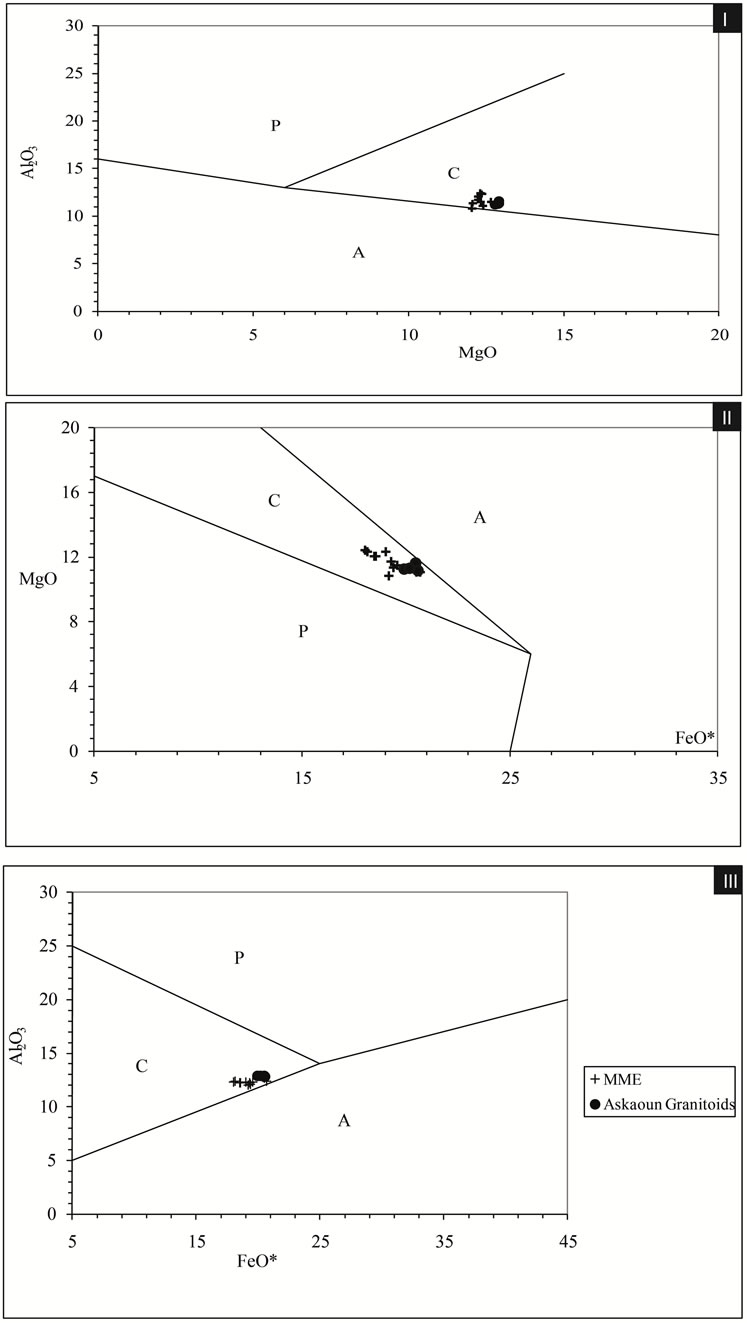
Figure 5. Biotite composition diagrams showing the classification (I; II; III) of magmas after [21]. (I) Al2O3 vs MgO diagram; (II) MgO vs FeO* Diagram; (III) Al2O3 vs FeO* Diagram (Field A: anorogenic alkaline suites; Field P: peraluminous (including S-type) suites; Field C: calc-alkaline orogenic suites).
to constrain the emplacement depths of batholiths or vertical displacements of crust [13,33,36-38]. There are several calibrations for aluminum-in-hornblende barometry, including:
P (±3 kbar) = −3.92 + 5.03 Al total, r2 = 0.80, [7];
P (±1 kbar) = −4.76 + 5.64 Al total, r2 = 0.97, [8];
P (±0.5 kbar) = –3.46 + 4.23 Al total, r2 = 0.99, [9];
P (±0.6 kbar) = –3.01 + 4.76 Al total, r2 = 0.99, [11].
Estimation of the pressure of solidification of a calcalkaline granitoid body from the Al content of hornblende assumes that: 1) the equilibrium pressure of the hornblende barometer and the host rocks are the same and; 2) the equilibrium pressure of the hornblende is the same as the pressure of emplacement of the pluton. These assumptions were questioned by many authors [8, 39]. The computed pressure may be affected by ion substitutions in hornblende, oxygen fugacity, volatiles and magma composition. Also, the computed pressure may reflect the level at which the hornblende crystallizes rather than the pressure at which the granite consolidates (upward movement may continue after hornblende crystallization, [39].
In this study, we have chosen the calibration of [13] to calculate the crystallization pressures of the investigated Tifnoute valley plutonic rocks and their MMEs, as this calibration is more reliable for considering the influence of temperature and oxygen fugacity on the pressure calculation than the other methods [33,38].
The new calibration of [13] is as follows:
P (±0.6 kbar) = 4.76 Al total − 3.01 − {[T (˚C) − 675]/85} × {0.530 Al total + 0.005294 [T (˚C) − 675]}, r2 = 0.99 The results yielded a pressure range of 0.9 to 4.66 Kbar at 505˚C to 611˚C in the host rocks, and 0.9 to 1.87 Kbar at 563˚C to 633˚C in the MMEs (Table 1). Other calibration to calculate the pressure was used for comparison (Table 1). By using a conversion factor of 1 kbar = 3.7 km for continental crust [40] and an error factor calculated for the pressure of ±0.5 kbar, these values correspond to emplacement depths between ~3.3 and 17 km.
5.5. Oxygen Fugacity
Oxygen fugacity (or oxygen potential) is a powerful mechanism for understanding crystallization of igneous and metamorphic rocks under variable pressure, temperature, and melt composition. Oxygen fugacity is defined as ƒO2 = γ*PO2 where γ is the fugacity coefficient and PO2 is the partial pressure of oxygen. Oxygen fugacity values are shown on a logarithmic scale.
The intrinsic oxygen fugacity of magma is related to its source of material, which in turn depends on tectonic setting. I-type granites are relatively oxidized, while sedimentary-derived granitic magmas are usually reduced. It is difficult to establish the original oxygen fugacities of primary magmas from the study of granitoids, as magnetite usually becomes Ti free during slow cooling and ilmenite undergoes one or more stages of oxidation and exsolution [41]. However, some inferences on the oxidation state of the magma can be made using the rock mineral assemblage and mineral chemistry. Mg-rich amphiboles suggest relatively oxidized magmas. The occurrence of euhedral titanite and magnetite as early-crystallizing phases in felsic rocks indicate that magma was relatively oxidized [42].
According to [43], the assemblages of titanite + magnetite + quartz in granitic rocks permit an estimation of relative oxygen fugacity. The estimated LogfO2 bases on [43] equilibrium expression of LogfO2= −30930/T + 14.98 + 0.142(P − 1)/T (where, T is temperature in Kelvin and P is pressure in bars). Temperatures and pressures estimated from hornblende-plagioclase thermometry and aluminum-inhornblende barometer were used in these calculations. The results of oxygen fugacity range from −24.8 to −19.2 in the host rocks and their MMEs (Table 1), which show that the calc-alkaline, and K-rich magma crystallized in low oxygen fugacity (fO2).
6. Conclusions
The main findings of the present work can be summarized as follows:
The mineralogical composition in the MMEs is similar to that of host rocks in the Askaoun pluton but with different proportion.
Compositional variation of plagioclase, amphibole, and biotite in MMEs and host rocks are more or less similar. This feature most likely evolved by reequilibrating during magma mixing and mingling events at 2.25 Kbar (average pressure) during the emplacement of Askaoun pluton.
Biotite compositions clearly define the nature of magmas from which they have been crystallized. Based on chemistry of biotites, Askaoun pluton is formed from calc-alkaline magma.
The application of Al-in-hornblende barometry indicated a minimum pressure of 0.9 ± 0.6 kbar and a maximum of 4.66 ± 0.6 kbar for the host rocks and their MMEs from the Askaoun pluton.
The aluminum-in-hornblende barometer, hornblendeplagioclase thermometer and the assemblage quartz-magnetite and titanite, were used to calculate pressure, temperature and oxygen activity, respectively. The host rocks and their MMEs from Askaoun pluton were emplaced at an average depth of (6.5 km), and a average temperature between 505˚C and 633˚C from a highly oxidized magma (LogfO2: −24.8 - −19.2).
REFERENCES
- M. Berrahma and M. Delaloye, “Données Géochronologiques Nouvelles sur le Massif Volcanique du Sirwa (AntiAtlas, Maroc),” Journal of African Earth Sciences, Vol. 9, No. 3, 1989, pp. 651-656. doi:10.1016/0899-5362(89)90049-3
- J. P. Liégeois, A. Benhallou, A. Azzouni-Sekkal, R. Yahiaoui and B. Bonin, “The Hoggar Swell and Volcanism: Reactivation of the Precambrian Tuareg Shield during Alpine Convergence and West African Cenozoic Volcanism,” In: G. R. Foulger, J. H. Natland, D. C. Presnall, D. L. Anderson, Eds., Plates, Plumes and Paradigms, Geological Society of America Special Paper, Vol. 388, 2005, pp. 379-400. doi:10.1130/0-8137-2388-4.379
- M. Regragui,“Les Formation Volcano-Sédimentaire et le Magmatisme Orogénique et Anorogénique du Néoprotérozoïque Supérieur et Terminal d’Askaoun (Siroua Occidental, Anti Atlas Central Maroc) Pétrologie, Géochimie et Typologie des Zircons,” Ph.D. Thesis, Université Cadi Ayyad, Marrakech, 1997.
- R. J. Thomas, L. P. Chevallier, P. G. Gresse, R. E. Harmer, B. M. Eglington, R. A. Armstrong, C. H. De Beer, J. E. J. Martini, G. S. De Kock, P. H. Macey and B. A. Ingram, “Precambrian Evolution of the Sirwa Window, AntiAtlas Orogen, Morocco,” Precambrian Research, Vol. 118, No. 1-2, 2002, pp. 1-57. doi:10.1016/S0301-9268(02)00075-X
- R. J. Thomas, A. Fekkak, N. Ennih, E. Errami, S. C. Loughlin, P. G. Gresse, L. P. Chevallier and J. P. Liégeois, “A New Lithostratigraphic Framwork for the Anti-Atlas Orogen, Morocco,” Journal of African Earth Sciences, Vol. 39, No. 3-5, 2004, pp. 217-226. doi:10.1016/j.jafrearsci.2004.07.046
- A. Toummite, J. P. Liégeois, D. Gasquet , O. Bruguier, E. H. Beraaouz and M. Ikenne, “Field, Geochemistry and Sr-Nd Isotopes of the Pan-African Granitoids from the Tifnoute Valley (Sirwa, Anti-Atlas, Morocco): A Post- Collisional Event in a Metacratonic Setting,” Mineralogy and Petrology, Special Issue: Gondwana Collision, 2012.
- J. M. Hammarstrom and E. A. Zen, “Aluminium in Hornblende: An Empirical Igneous Géobaromètre,” American Mineralogist, Vol. 71, No. 11-12, 1986, pp. 1297-1313.
- L. S. Hollister, G. C. Grissom, E. K. Peters, H. H. Stowell and V. B. Sisson, “Confirmation of the Empirical Calibration of Al in Hornblende with Pressure of Solidification of Calc-Alkaline Plutons,” American Mineralogist, Vol. 72, No. 3-4, 1987, pp. 231-239.
- M. C. Johnson and M. J. Rutherford, “Experimental Calibration of the Aluminium-in-Hornblende Geobarometer with Application to Long Valley Caldera (California) Volcanic Rocks,” Geology, Vol. 17, No. 9, 1989, pp. 837-841. doi:10.1130/0091-7613(1989)017<0837:ECOTAI>2.3.CO;2
- J. Blundy and T. J. Holland, “Calcic Amphibole Equilibria and a New Amphibole-Plagioclase Geothermometer,” Contributions to Mineralogy and Petrology, Vol. 104, No. 2, 1990, pp. 208-224. doi:10.1007/BF00306444
- M. W. Schmidt, “Amphibole Composition in Tonalite as a Function of Pressure: An Experimental Calibration of the Al-in-Hornblende Barometer,” Contributions to Mineralogy and Petrology, Vol. 110, No. 2-3, 1992, pp. 304-310. doi:10.1007/BF00310745
- T. Holland and J. Blundy, “Non-Ideal Interactions in Calcic Amphiboles and Their Bearing on Amphibole-Plagioclase Thermometry,” Contributions to Mineralogy and Petrology, Vol. 116, No. 4, 1994, pp. 433-447. doi:10.1007/BF00310910
- J. L. Anderson and D. R. Smith, “The Effects of Temperature and fO2 on the Al-in-Hornblende Barometer,” American Mineralogist, Vol. 80, No. 5-6, 1995, pp. 549-559. doi:10.1017/S0263593300006544
- J. L. Anderson, “Status of Thermobarometry in Granitic Batholiths,” Transactions of the Royal Society of Edinburgh: Earth Sciences, Vol. 87, No. 1-2, 1996, pp. 125-138.
- F. Ridolfi, A. Renzulli and M. Puerini, “Stability and Chemical Equilibrium of Amphibole in Calc-Alkaline Magmas: An Overview, New Thermobarometric Formulations and Application to Subduction-Related Volcanoes,” Contributions to Mineralogy and Petrology, Vol. 160, No. 1, 2010, pp. 45-66. doi:10.1007/s00410-009-0465-7
- B. E. Leake, “On Aluminous and Edenitic Amphiboles,” Mineralogical Magazine, Vol. 38, No. 296, 1971, pp. 389-407. doi:10.1180/minmag.1971.038.296.01
- B. E. Leake, “Nomenclature of Amphiboles: Report of the Subcommittee on Amphiboles of the International Commission on New Minerals and Mineral Names,” Mineralogical Magazine, Vol. 61, No. 405 1997, pp. 295-321. doi:10.1180/minmag.1997.061.405.13
- A. Mogessie, K. Ettinger, B. E. Leake and R. Tessardi, “AMPHIMA97: A Hypercard Program to Determine the Name of an Amphibole from Electron Microprobe and Wet Chemical Analyses,” Computers and Geosciences, Vol. 27, No. 10, 2001, pp. 1169-1178. doi:10.1016/S0098-3004(01)00034-6
- W. A. Deer, R. A. Howie and J. Zussman, “An Introduction to Rock-Forming Minerals,” 17th Edition, Longman Ltd., London, 1966, p. 528.
- E. Zen, “Tectonic significance of high pressure plutonic rocks in the Western Cordillera of North America,” In: W. G. Ernst, Ed., Metamorphism and Crustal Evolution of the Western United States, Prentice-Hall, Engelwood Cliffs, 1988, pp. 41-67.
- A. Abdel-Rahman, “Nature of Biotites from Alkaline, Calcalkaline and Peraluminous Magmas,” Journal of Petrology, Vol. 35, No. 2, 1994, pp. 525-541.
- M. Barriere and J. Cotton, “Biotites and Associated Minerals as Markers of Magmatic Fractionation and Deuteric Equilibration in Granites,” Contributions to Mineralogy and Petrology, Vol. 70, No. 2, 1979, pp. 183-192. doi:10.1007/BF00374447
- G. A. R. De Albuquerque, “Geochemistry of Biotites from Granitic Rocks, Northern Portugal,” Geochimica et Cosmochimica Acta, Vol. 37, No. 2, 1973, pp. 1779-802. doi:10.1016/0016-7037(73)90163-4
- M. D. Foster, “Interpretation of the Composition of Trioctahedral Micas,” US Government Printing Office, Washington DC, 1960, pp. 1-49.
- M. L. Kabesh and A. M. Refaat, “On the Chemistry of Biotites and Variation of Ferrous-Ferric Ratios in the Granitic Rocks of Umm Naggat Stock, Egypt,” Neues Jahrbuch fur Mineralogy Abhandlungen, Vol. 124, No. 1, 1975, pp. 47-60.
- F. Moazamy, “Application of Biotite Composition in Determination of Tectonic Setting of Granitoids of BorujerdHamedan,” M.S.C. Thesis, Tarbiat Moalem University of Iran, Tehran, 2006.
- H. Nachit, A. Ibhi, E. H. Abia and M. Ben Ohoud, “Discrimination between Primary Magmatic Biotites, Reequilibrated Biotites and Neoformed Biotites,” Comptes Rendus Geoscience, Vol. 337, No. 16, 2005, pp. 1415-1420. doi:10.1016/j.crte.2005.09.002
- A. M. R. Neiva, “The Geochemistry of Biotites from Granites of Northern Portugal with Special Reference to Their Tin Content,” Mineralogical Magazine, Vol. 40, No. 313, 1976, pp. 453-466.
- S. R. Nockolds, “The Relation between Chemical Composition and Paragenesis in the Biotite Micas of Igneous Rocks,” American Journal of Science, Vol. 245, No. 7, 1947, pp. 401-420. doi:10.2475/ajs.245.7.401
- E. S. Sapountzis, “Biotites from the Sithonia Igneous Complex (North Greece),” Neues Jahrbuch fur Mineralogy Abhandlungen, Vol. 126, No. 3, 1976, pp. 327-341.
- A. T. Shabbani and A. Lalonde, “Composition of Biotite from Granitic Rocks of the Canadian Appalachian: A Potential Tectonomagmatic Indicator?” The Canadian Mineralogist, Vol. 41, No. 6, 2003, pp. 1381-1396. doi:10.2113/gscanmin.41.6.1381
- J. A. Speer, “Micas in Igneous Rocks,” In: S. W. Bailey, Ed., Micas: Reviews in Mineralogy Volume 13, Mineralogical Society of America, Washington DC, 1984, pp. 299-356.
- E. Stein and E. Dietl, “Hornblende Thermobarometry of Granitoids from the Central Odenwald (Germany) and Their Implications for the Geotectonic Development of the Odenwald,” Mineralogy and Petrology, Vol. 72, No. 1-3, 2001, pp. 185-207. doi:10.1007/s007100170033
- W. G. Ernst, “Paragenesis and Thermobarometry of Camphiboles in the Barcroft Granodioritic Pluton, Central White Mountains, Eastern California,” American Mineralogist, Vol. 87, No. 4, 2002, pp. 478-490.
- M. J. Rutter, S. R. Van der Laan and P. J. Wyllie, “Experimental Data for a Proposed Empirical Igneous Geobarometer: Aluminium in Hornblende at 10 kbar Pressure,” Geology, Vol. 17, No. 10, 1989, pp. 897-900. doi:10.1130/0091-7613(1989)017<0897:EDFAPE>2.3.CO;2
- J. J. Ague and M. T. Brandon, “Tilt and Northward Offset of Cordilleran Batholiths Resolved Using Igneous Barometry,” Nature, Vol. 360, No. 6400, 1992, pp. 146-149. doi:10.1038/360146a0
- J. J. Ague and M. T. Brandon, “Regional Tilt of the Mount Stuart Batholith, Washington, Determined Using Aluminum-in-Hornblende Barometry: Implications for Northward Translation of Baja British Columbia,” Geological Society of American Bulletin, Vol. 108, No. 4, 1996, pp. 471-488. doi:10.1130/0016-7606(1996)108<0471:RTOTMS>2.3.CO;2
- S. H. Zhang, Y. Zhao and B. Song, “Hornblende Thermobarometry of the Carboniferous Granitoids from the Inner Mongolia Paleouplift: Implication for the Tectonic Evolution of the Northern Margin of the North China Block,” Mineralogy and Petrology, Vol. 87, No. 1-2, 2006, pp. 123-141. doi:10.1007/s00710-005-0116-2
- E. D. Ghent, J. Nicholls, P. S. Siminy, H. H. Sevigny and M. Z. Stout, “Hornblende Geobarometry of the Nelson Batholith, Southeastern British Columbia: Tectonic Implications,” Canadian Journal of Earth Science, Vol. 28, No. 12, 1991, pp. 1982-1991. doi:10.1139/e91-180
- A. J. Tulloch and G. A. Challis, “Emplacement Depths of Paleozoic-Mesozoic Plutons from Western New Zealand Estimated by Hornblende-Al Geobarometry,” New Zealand Journal of Geology and Geophysics, Vol. 43, No. 4, 2000, pp. 555-567. doi:10.1080/00288306.2000.9514908
- S. E. Haggerty, “Opaque Mineral Oxides in Terrestrial Igneous Rocks,” Mineralogical Society of America Short Course Notes 3, Washington DC, 1976, pp. 101-300.
- M. Enami, K. Suzuki, J. G. Liou and D. K. Bird, “Al-Fe3+ and F-OH Substitutions in Titanite and Constrains on Their P-T Dependence,” European Journal of Mineralogy, Vol. 5, No. 2, 1993, pp. 231-291.
- D. R. Wones, “Significance of the Assemblage Titanite + Magnetite + Quartz in Granitic Rocks,” American Mineralogist, Vol. 74, 1989, pp. 744-749.
- A. Michard, O. Saddiqi, A. Chlouan and D. F. De Lamote, “Continental Evolution: The Geology of Morocco, Structures, Stratigraphy and Tectonics of the Africa-AtlanticMediterranean Triple Junction,” Springer, Berlin, 2008, p. 405.
- P. G. Gresse, C. H. De Beer, G. S. De Kock, R.J. Thomas, L.P. Chevallier, “Carte et Notice Explicative de la Carte Géologique du Maroc au 1/50,000 Feuille Tachoukacht,” Notes et Mémoires du Service Géologique du Maroc, No 392, 2000.
- G. Choubert, “Carte Géologique du Maroc au 1/500,000, feuille Marrakech,” Notes et Mémoires du Service Géologique du Maroc, Vol. 70, 1957.
NOTES
*Corresponding author.

